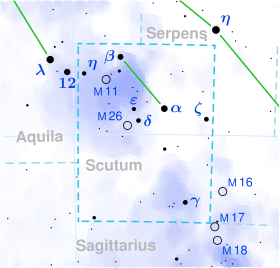Beta Scuti
| Observation data Epoch J2000 Equinox J2000 | ||
|---|---|---|
| Constellation | Scutum | |
| Right ascension | 18h 47m 10.474s[1] | |
| Declination | −04° 44′ 52.342″[1] | |
| Apparent magnitude (V) | 4.22[2] | |
| Characteristics | ||
| Evolutionary stage | Giant star | |
| Spectral type | G4IIa[3] | |
| U−B color index | +0.84[4] | |
| B−V color index | +1.09[4] | |
| Absolute magnitude (MV) | −2.99[5] | |
Argument of periastron (ω)(secondary) | 33.9° | |
| Details | ||
Rotational velocity (v sin i) | 7.8[9] km/s | |
SAO 142618, CCDM 18472-0445 | ||
| Database references | ||
| SIMBAD | data | |
Beta Scuti,
light years from the Sun
.
Characteristics
This is a
spectroscopic binary with an orbital period of 2.3 years and eccentricity around 0.35.[10] The secondary is about 3.3 magnitudes dimmer than the primary and estimated as type B9 based on the flux of far-ultraviolet radiation.[11]
The primary component has an
milliarcseconds by the Navy Precision Optical Interferometer, which gives it a physical radius of approximately 49 R☉ at the estmated distance.[7]
The secondary was directly detected with a magnitude difference of 3.6 at a separation of about 17 milli-arcseconds using observations from the Navy Precision Optical Interferometer.[12] This detection was significant as observations with the Hubble Space Telescope which indicated a companion star was present were not definitive.[13] With an orbit and a parallax the sum of the masses of the two stars can be determined via a dynamical parallax.[14] This eventually can yield a precise mass for the evolved giant primary star.
Beta Scuti was a latter designation of 6 Aquilae.[15]
References
- ^ S2CID 244398875. Gaia DR3 record for this source at VizieR.
- Bibcode:1999A&A...352..495M
- ^ doi:10.1086/191373.
- ^ Bibcode:2002yCat.2237....0D.
- ^ S2CID 119257644. Vizier catalog entry
- S2CID 120199240.
- ^ ISSN 0004-6256.)
{{cite journal}}: CS1 maint: multiple names: authors list (link - S2CID 119258214.
- S2CID 119387088.
- doi:10.1086/313152.
- S2CID 118803592.
- doi:10.1086/427853.
- )
- S2CID 118445625.

